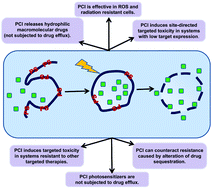Photochemical activation of drugs for the treatment of therapy-resistant cancers
Abstract
Resistance to chemotherapy, molecular targeted therapy as well as radiation therapy is a major obstacle for cancer treatment. Cancer resistance may be exerted through multiple different mechanisms which may be orchestrated as observed in multidrug resistance (MDR). Cancer resistance may be intrinsic or acquired and often leaves patients without any treatment options. Strategies for alternative treatment modalities for resistant cancer are therefore highly warranted. Photochemical internalization (PCI) is a technology for cytosolic delivery of macromolecular therapeutics based on the principles of photodynamic therapy (PDT). The present report reviews the current knowledge of PCI of therapy-resistant cancers. In summary, PCI may be able to circumvent several of the major mechanisms associated with resistance towards chemotherapeutics including increased expression of drug efflux pumps, altered intracellular drug distribution and increased ROS scavenging. Current data also suggest PCI of targeted toxins as highly effective in cancers resistant to clinically available targeted therapy such as monoclonal antibodies (mAbs) and tyrosine kinase inhibitors (TKIs). PCI may therefore, in general, represent a future treatment option for cancers resistant to other therapies.


 Please wait while we load your content...
Please wait while we load your content...